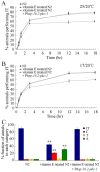High concentration of vitamin E decreases thermosensation and thermotaxis learning and the underlying mechanisms in the nematode Caenorhabditis elegans
- PMID: 23951104
- PMCID: PMC3741368
- DOI: 10.1371/journal.pone.0071180
High concentration of vitamin E decreases thermosensation and thermotaxis learning and the underlying mechanisms in the nematode Caenorhabditis elegans
Abstract
α-tocopherol is a powerful liposoluble antioxidant and the most abundant isoform of vitamin E in the body. Under normal physiological conditions, adverse effects of relatively high concentration of vitamin E on organisms and the underlying mechanisms are still largely unclear. In the present study, we used the nematode Caenorhabditis elegans as an in vivo assay system to investigate the possible adverse effects of high concentration of vitamin E on thermosensation and thermotaxis learning and the underlying mechanisms. Our data show that treatment with 100-200 µg/mL of vitamin E did not noticeably influence both thermosensation and thermotaxis learning; however, treatment with 400 µg/mL of vitamin E altered both thermosensation and thermotaxis learning. The observed decrease in thermotaxis learning in 400 µg/mL of vitamin E treated nematodes might be partially due to the moderate but significant deficits in thermosensation, but not due to deficits in locomotion behavior or perception to food and starvation. Treatment with 400 µg/mL of vitamin E did not noticeably influence the morphology of GABAergic neurons, but significantly decreased fluorescent intensities of the cell bodies in AFD sensory neurons and AIY interneurons, required for thermosensation and thermotaxis learning control. Treatment with 400 µg/mL of vitamin E affected presynaptic function of neurons, but had no remarkable effects on postsynaptic function. Moreover, promotion of synaptic transmission by activating PKC-1 effectively retrieved deficits in both thermosensation and thermotaxis learning induced by 400 µg/mL of vitamin E. Therefore, relatively high concentrations of vitamin E administration may cause adverse effects on thermosensation and thermotaxis learning by inducing damage on the development of specific neurons and presynaptic function under normal physiological conditions in C. elegans.
Conflict of interest statement
Figures






Similar articles
-
Environmental-temperature and internal-state dependent thermotaxis plasticity of nematodes.Curr Opin Neurobiol. 2022 Jun;74:102541. doi: 10.1016/j.conb.2022.102541. Epub 2022 Apr 18. Curr Opin Neurobiol. 2022. PMID: 35447377 Review.
-
Molecular mechanism for trimetric G protein-coupled thermosensation and synaptic regulation in the temperature response circuit of Caenorhabditis elegans.Neurosci Res. 2013 Jul;76(3):119-24. doi: 10.1016/j.neures.2013.03.008. Epub 2013 Mar 28. Neurosci Res. 2013. PMID: 23542220 Review.
-
Bidirectional thermotaxis in Caenorhabditis elegans is mediated by distinct sensorimotor strategies driven by the AFD thermosensory neurons.Proc Natl Acad Sci U S A. 2014 Feb 18;111(7):2776-81. doi: 10.1073/pnas.1315205111. Epub 2014 Feb 3. Proc Natl Acad Sci U S A. 2014. PMID: 24550307 Free PMC article.
-
Feeding state functionally reconfigures a sensory circuit to drive thermosensory behavioral plasticity.Elife. 2020 Oct 19;9:e61167. doi: 10.7554/eLife.61167. Elife. 2020. PMID: 33074105 Free PMC article.
-
Regulator of Calcineurin (RCAN-1) Regulates Thermotaxis Behavior in Caenorhabditis elegans.J Mol Biol. 2015 Nov 6;427(22):3457-3468. doi: 10.1016/j.jmb.2015.07.017. Epub 2015 Jul 29. J Mol Biol. 2015. PMID: 26232604
Cited by
-
Coal combustion related fine particulate matter (PM2.5) induces toxicity in Caenorhabditis elegans by dysregulating microRNA expression.Toxicol Res (Camb). 2017 Apr 24;6(4):432-441. doi: 10.1039/c7tx00107j. eCollection 2017 Jul 1. Toxicol Res (Camb). 2017. PMID: 30090511 Free PMC article.
-
The C. elegans miR-235 regulates the toxicity of graphene oxide via targeting the nuclear hormone receptor DAF-12 in the intestine.Sci Rep. 2020 Oct 9;10(1):16933. doi: 10.1038/s41598-020-73712-x. Sci Rep. 2020. PMID: 33037257 Free PMC article.
-
Full toxicity assessment of Genkwa Flos and the underlying mechanism in nematode Caenorhabditis elegans.PLoS One. 2014 Mar 13;9(3):e91825. doi: 10.1371/journal.pone.0091825. eCollection 2014. PLoS One. 2014. PMID: 24626436 Free PMC article.
-
Biological effects, translocation, and metabolism of quantum dots in the nematode Caenorhabditis elegans.Toxicol Res (Camb). 2016 Apr 29;5(4):1003-1011. doi: 10.1039/c6tx00056h. eCollection 2016 Jul 1. Toxicol Res (Camb). 2016. PMID: 30090407 Free PMC article. Review.
-
Wnt Ligands Differentially Regulate Toxicity and Translocation of Graphene Oxide through Different Mechanisms in Caenorhabditis elegans.Sci Rep. 2016 Dec 13;6:39261. doi: 10.1038/srep39261. Sci Rep. 2016. PMID: 27958363 Free PMC article.
References
-
- Ernst IMA, Pallauf K, Bendall JK, Paulsen L, Nikolai S, et al. (2013) Vitamin E supplementation and lifespan in model organisms. Ageing Res Rev 12: 365–375. - PubMed
-
- Yun JS, Na HK, Park K, Lee YH, Kim EY, et al. (2005) Protective effects of vitamin E on endocrine disruptors, PCB-induced dopaminergic neurotoxicology. Toxicology 216: 140–146. - PubMed
-
- Tome AR, Feng D, Freitas RM (2010) The effects of alpha-tocopherol on hippocampal oxidative stress prior to a pilocarpine-induced seizures. Neurochem Res 35: 580–587. - PubMed
Publication types
MeSH terms
Substances
LinkOut - more resources
Full Text Sources
Other Literature Sources
Medical

